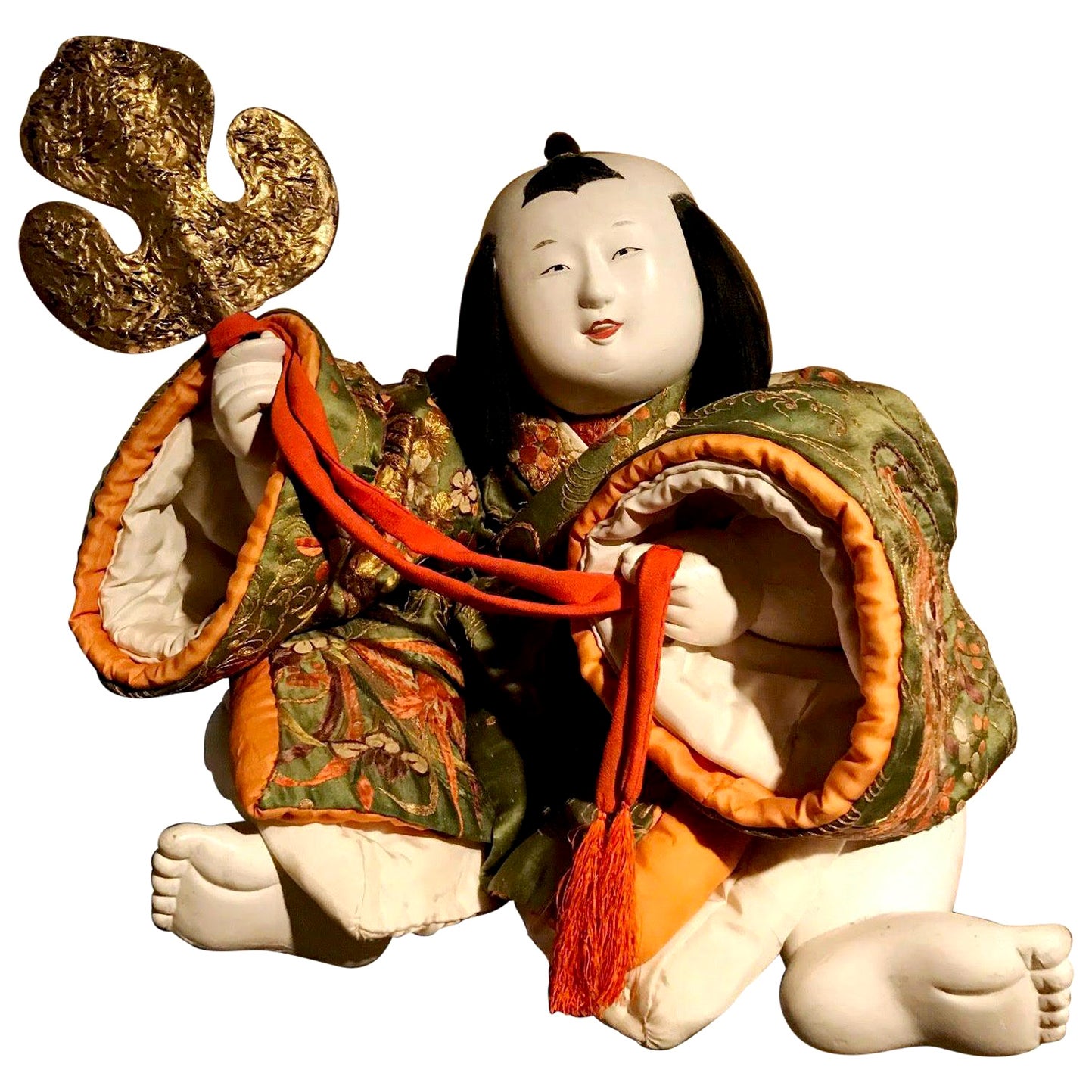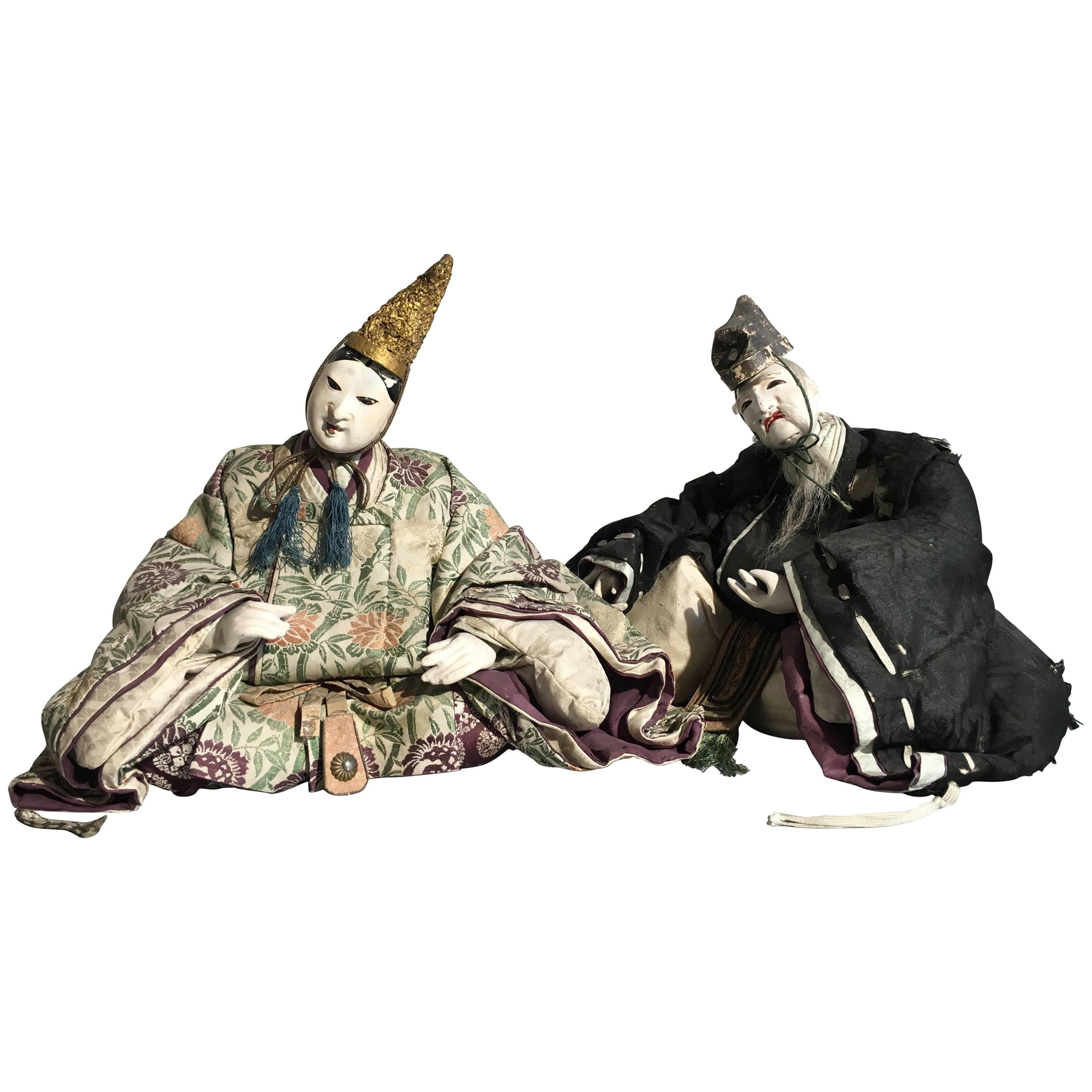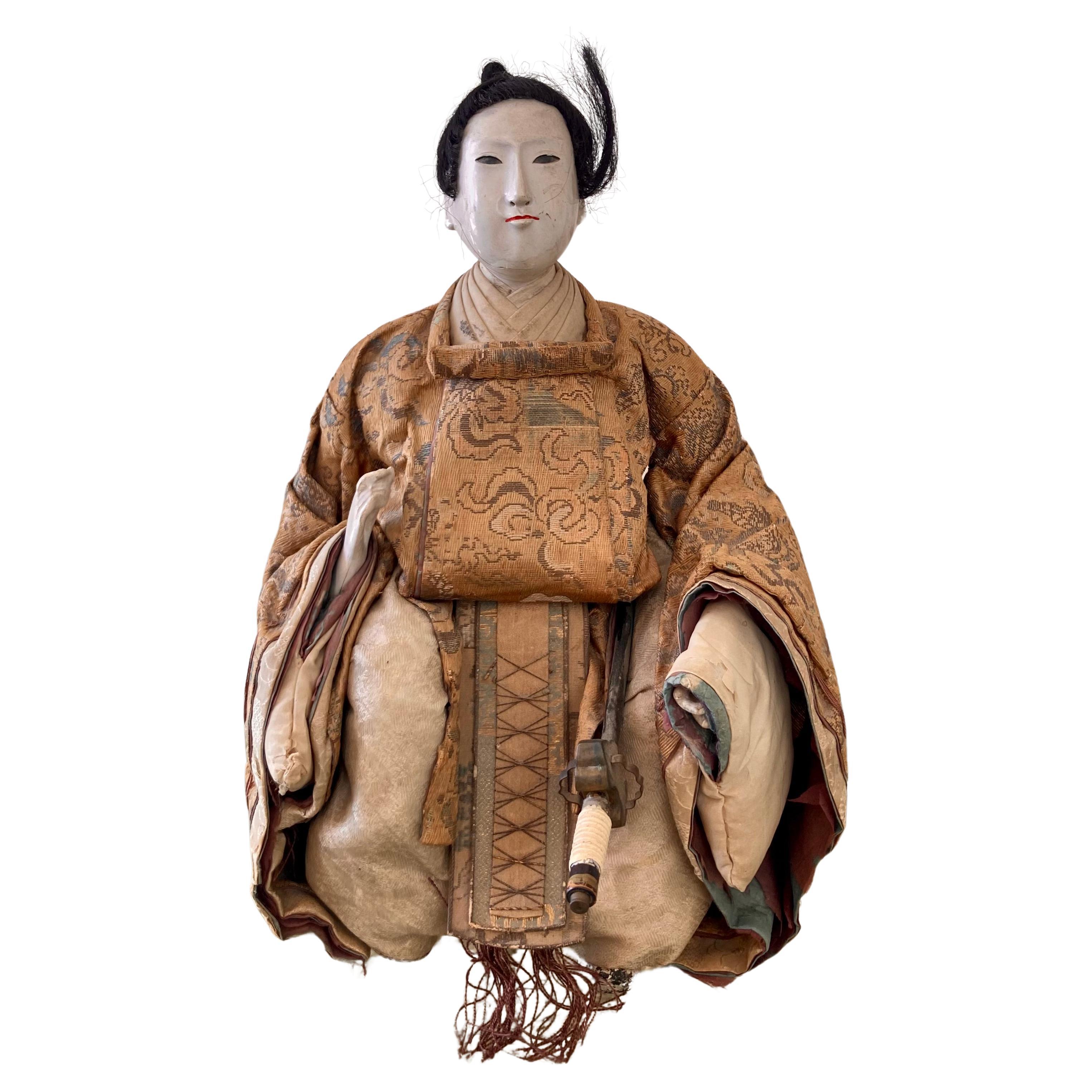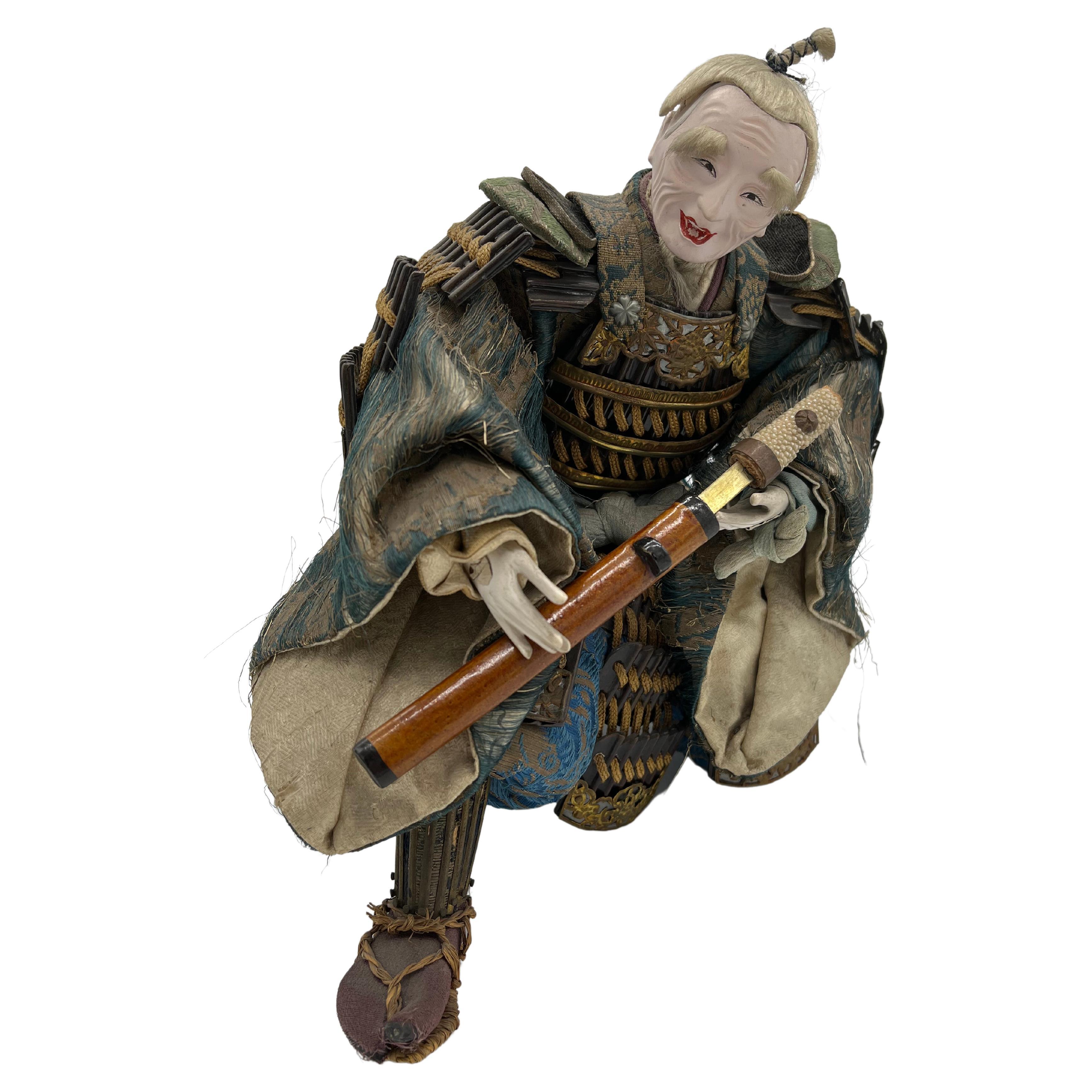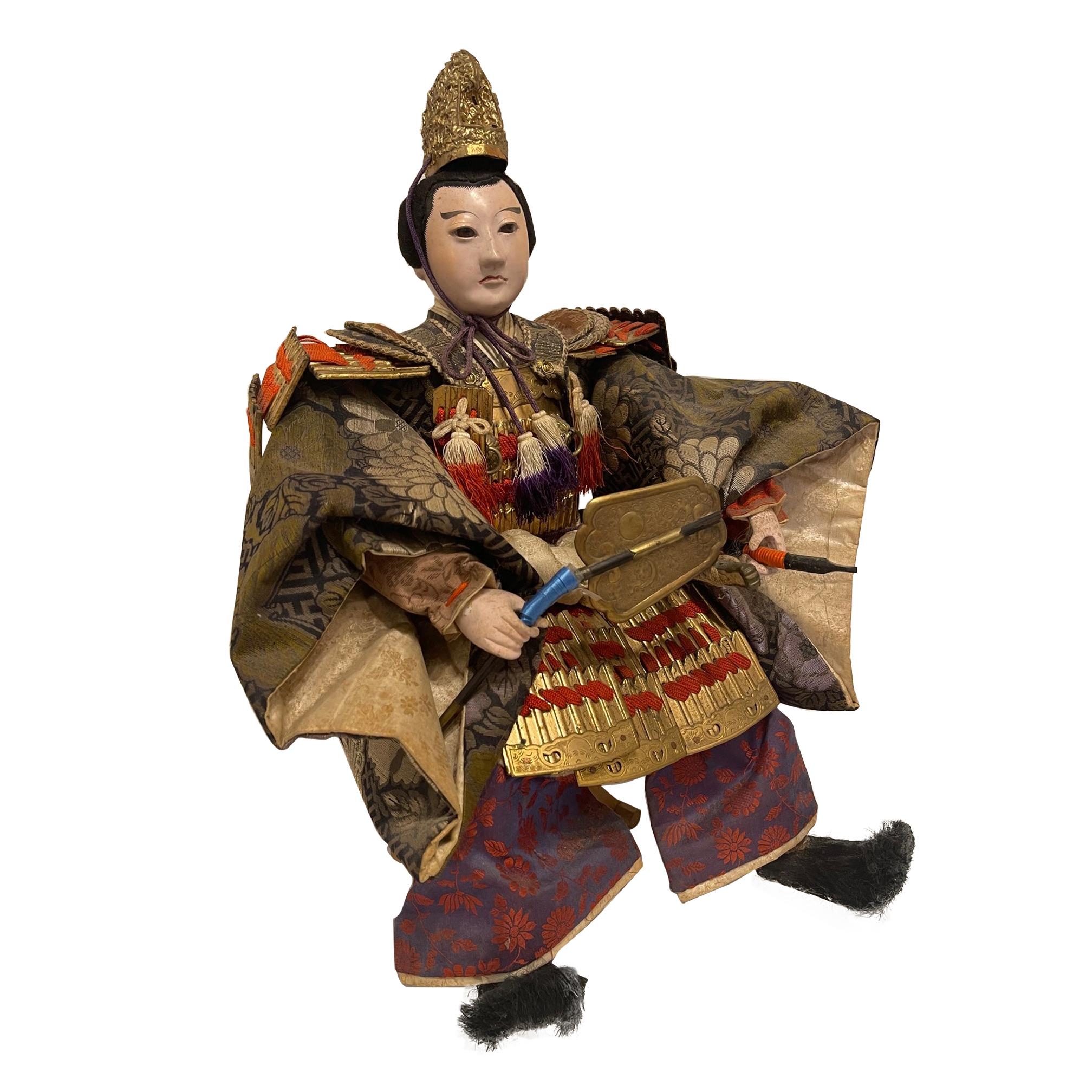Items Similar to Japanese Edo-period gosho’ningyô 御所人形 (palace doll) of plump, seated child
Want more images or videos?
Request additional images or videos from the seller
1 of 21
Japanese Edo-period gosho’ningyô 御所人形 (palace doll) of plump, seated child
About the Item
A charming gosho’ningyô (palace doll) of plump, seated child with a brilliant white skin and a small delicately elegant face, reminiscent of a young noble. The doll is playfully raising its left hand to display a golden ball, pointing at it with a sense of joy. He is wearing a soft brown silk bib with a golden brocade design.
The child’s hair is styled in a natural bob. The doll’s soft, white skin texture is achieved through the application of multiple layers of gofun, a fine powder made from the itabo oyster (Ostrea denselamellosa).
The toy in his hand is not removable.
Gosho Ningyô: Also known as “Court Dolls”, these chubby, white-skinned, baby dolls were given as gifts to aristocrats for hundreds of years. They are thought to bring good luck, prosperity, and happiness. Gosho Ningyo would be passed down to the next generation as part of a family member’s art collection.
When shipped we will add a certificate of authenticity.
Price including insured shipping.
- Dimensions:Height: 7.88 in (20 cm)Width: 7.09 in (18 cm)Depth: 6.3 in (16 cm)
- Materials and Techniques:
- Place of Origin:
- Period:
- Date of Manufacture:First half 19th century (Late Edo period)
- Condition:Wear consistent with age and use. Considering the age, which is over 200 years old, the doll is in a very good condition with traces of wear conform age, like age-related cracks of the gofun. Please take a close look at the photos for a clear condition reference.
- Seller Location:Amsterdam, NL
- Reference Number:
About the Seller
5.0
Vetted Seller
These experienced sellers undergo a comprehensive evaluation by our team of in-house experts.
Established in 1996
1stDibs seller since 2022
16 sales on 1stDibs
Typical response time: 10 hours
- ShippingRetrieving quote...Ships From: Zwanenburg, Netherlands
- Return PolicyA return for this item may be initiated within 14 days of delivery.
More From This SellerView All
- Signed Japanese Edo suji’bachi kabuto (helmet) with a moon & cloud maedateLocated in Amsterdam, NLAn antique, outstanding signed suji’bachi kabuto (helmet with ridges) surmounted by a gilt metal maedate (forecrest) shaped like a full moon emerging from the clouds heightened by a ...Category
Antique Early 19th Century Japanese Antiquities
MaterialsMetal, Iron
- Large pair of Japanese ‘Jyôka’ 常花, sets of gilded lotus flowers and -leaves.Located in Amsterdam, NLA spectacular pair of black glass vases each adorned with 13 large handmade gilded wooden lotus flowers and -leaves with refined details. Such a set is known as ‘Jyôka’, and are typically positioned on or beside an altar in a Buddhist temple. The lotus flowers are at different stages of their life (unfurled lotus leaves, buds and blooms) and symbolize the journey towards Buddhist enlightenment. What sets this pair apart is its size; it is considerably larger than many similar sets, making it a rare find. As well as that it has such an extensive array of gilded flowers. The flowers, which are detachable, allow for customizable arrangements within the vases. Period: Japan – lotuses...Category
Antique Late 19th Century Japanese Antiquities
MaterialsGlass, Giltwood, Lacquer
- Rare set of 2 Japanese suits-of-armour, complete with 2 matching folding screensLocated in Amsterdam, NLImportant unique set of two suits-of-armour (yoroi), complete with two high six-panel screens, that belong together as is indicated by the used family crests (mon). Two crests are used, both belonging to the Nakagawa family of Oka Castle, Ôita prefecture on Kyûshû. They are: – the Nakagawa-kurusu, a circle depicting a Celtic-like cross through a ring. The cross was originally a Christian symbol but after the ban on Christianity in Japan the use of a hidden cross in family crests could continue. – the Nakagawa-kashiwa, two leaves of the Japanese Emperor Oak turned to each other (dakikashiwa mon). The remarkable aspect of this ensemble is the presence of matching crests on both the yoroi and the accompanying folding screens. The kurusu and kashiwa crests adorning the yoroi are elegantly replicated on the screens, providing compelling evidence that these pieces form a harmonious and unified set. This exceptional cohesion between the armour and screens further enhances their artistic and historical value. After the warlord Toyotomi Hideyoshi (1537-1598) had interfered in the battle between the Lord of Bungo Province Ôtomo Yoshi-mune (1558-1605) and the Shimazu of Hyûga Province, he split the Bungo Province in a number of small fiefs and transferred in 1594 Nakagawa Hideshige (1570-1612) from Miki Castle in the Harima Fief to Oka Castle in Kyûshû. The Nakagawa family stayed in possession of Oka Castle till the abolishment of the military use of castles in 1873. In 1884 the Nakagawa family received the title of Count (a title in use till the abolishment of aristocracy in 1947). After the Nakagawa’s left, the castle and the building soon dilapidated and is now known as Oka Castle Ruins. The castle is located in Taketa Village part of Taketa Town in Ôita Province on Kyûshû. > Set of two tall byôbu (folding screens), painted with large red jinmaku (camp enclosure curtain) on a gold leaf ground. The curtains show both crests of the Nakagawa family: one screen depicts two Nakagawa-kurusu crests next to a Nakagawa-kashi crest in the middle, and the other shows the symbols the other way round. Dimensions: Total width 148.66 in/377.6 cm (2 x 25.35 in/64.4 cm, 4 x 24.48 in/62.2 cm); Height 72.63 in/184.5 cm. Period: Japan – Late Edo period (First half 19th century), and maybe even older. > Yoroi with Nakagawa-kashiwa crest: A Japanese black lacquered suit-of-armour (yoroi) completely laced with orange cords (kuro’urushinuri hi’ito odoshi nimai’dô’maru). A thirty-two plate suji’bachi kabuto (helmet with raised ridges) with in front a maedate (fore crest) -with traces of gilding- in the shape of flames, resembling a mythical flaming bird flying down. The fukikaeshi (face guards) and the mabizashi (visor) have the Nakagawa-kashiwa crest in gold maki-e lacquer. Five curved ‘itazane’-plate neck guards (shikoro) laced with orange cords. Together with an ‘angry man...Category
Antique 18th Century Japanese Antiquities
MaterialsGold Leaf, Iron, Metal
- Pair of Japanese High Quality Chôshi 銚子 'Sake Ewers', Signed 'Sei’ô' 晴王Located in Amsterdam, NLPair of high quality cast iron chôshi (sake ewers) with a detailed lacquered lid. Its body with a refined embossed design of a bird of prey (môchô) perched o...Category
Antique Late 19th Century Japanese Antiquities
MaterialsIron
- Pair of Japanese cast iron chôshi 銚子 (sake kettles) with lacquered lidsLocated in Amsterdam, NLPair of enticing cast iron chôshi (sake kettles) with a detailed lacquered lid, raised by three low feet. Its rotund body with a subtle embossed design of stylized symbols, like myth...Category
Antique Early 19th Century Japanese Antiquities
MaterialsSilver, Iron
- Pair of Japanese Carved Wooden Temple Ornaments 木鼻 'Kibana' Shaped like Baku 獏Located in Amsterdam, NLA lovely pair of very detailed carved wooden temple ornaments (kibana) in the shape of elephant-like mythical creatures known as ‘Baku’. Baku are Japan...Category
Antique Early 19th Century Japanese Sculptures and Carvings
MaterialsWood
You May Also Like
- Japanese Late Edo Period Seated Imperial Gosho Ningyo DollLocated in New York, NYJapanese rare late Edo period large Imperial Gosho Ningyo doll. The piece depicts a cute chubby child with very white skin, small limbs and big head with ...Category
Antique 19th Century Japanese Edo Sculptures and Carvings
MaterialsTextile, Silk, Wood
- Pair of Japanese Edo Period Musha Ningyo Courtier DollsLocated in Austin, TXTwo exquisite Japanese musha ningyo dolls, crafted as courtiers, Edo Period, early 19th century, Japan. The older man can be identified as the h...Category
Antique Early 19th Century Japanese Edo Sculptures and Carvings
MaterialsShell, Brocade, Silk, Glass, Wood, Paint, Paper
- Japanese edo period shrine altarBy Vintage Japanese MonochromeLocated in CARLTON, AUElegant and sacred, rare look was its amazing wave textures. This beautiful piece with refined details shows a great stillness, which was made during edo period and executed with Jap...Category
Antique Early 17th Century Japanese Edo Antiquities
MaterialsCedar
- Asian 19th Century Ningyo DollLocated in Los Angeles, CABeautiful Asian 19th Century Ningyo doll. Great addition to your Asian inspired interiors and table tops.Category
Antique 19th Century Japanese Other Antiquities
MaterialsCotton
- Japanese Samurai Figure Hinaningyo, Edo PeriodLocated in Munich, BavariaAntique samurai doll called Hinaningyo; Japan, late EDO period Praised at the Tang-no-sekku boys' festival on May 5th as a sign of bravery, embodying the...Category
Antique Mid-18th Century Japanese Antiquities
MaterialsTextile, Wood
- Japanese Samurai Doll or Figure, Meiji Period, Circa 1830Located in Savannah, GAJapanese Samurai Doll or Figure, Meiji Period, circa 1830. Skirt purple and red colors.Category
Antique Early 19th Century Japanese Meiji Antiquities
MaterialsPorcelain
Recently Viewed
View AllMore Ways To Browse
1920 Art Deco Vase
Leaf Extendable
Studio Handmade Gold
Golden Lacquer Furniture
Small Table Small Dining Table Round
Mid Century Modern Industrial Chair
Country Style Ceramics
Arts Crafts Rug Mid Century
Unknown 1960s French
Outdoor Aluminium Table
Olivier Olivier
Revival Egyptian
Vintage Painted Iron Furniture
Gold Carved Gold Wood Mirrors
Mediterranean Style Rug
Vintage Regency Style Table
Large Brass Side Table
1950s Tray
